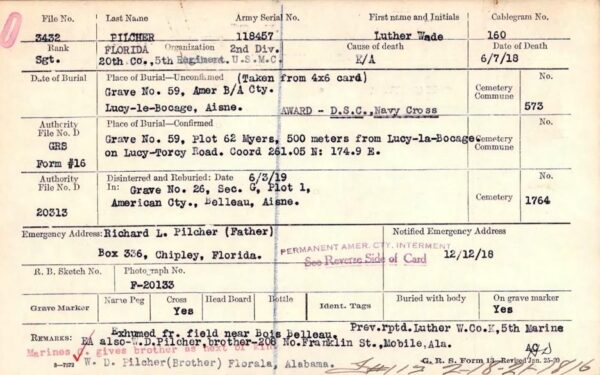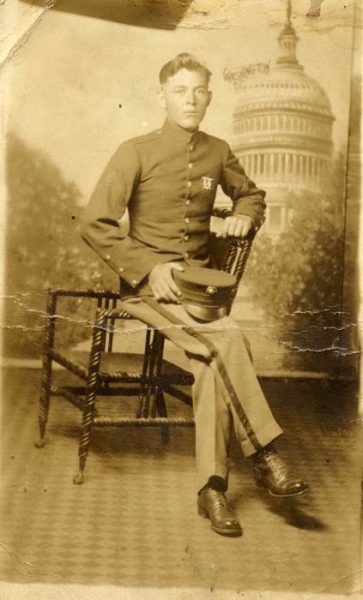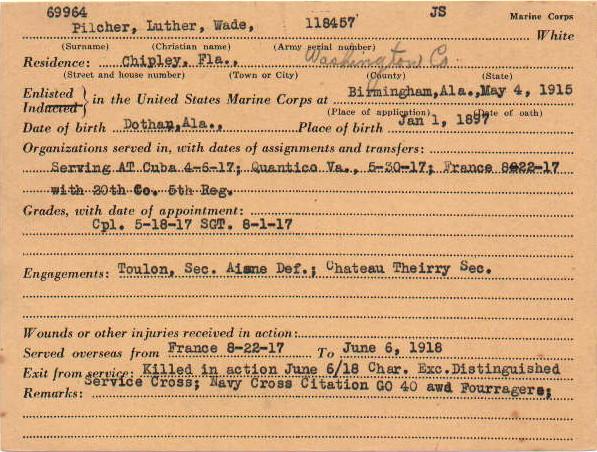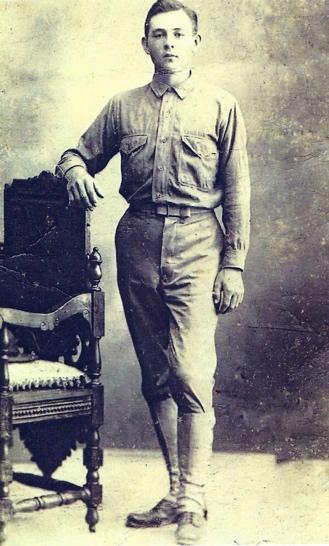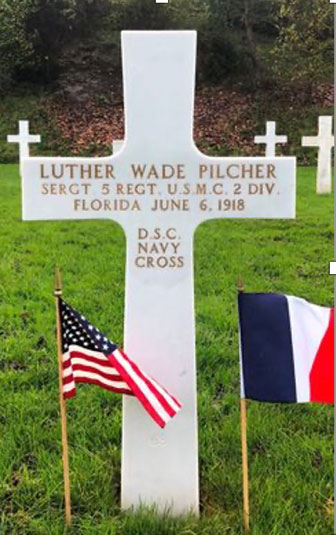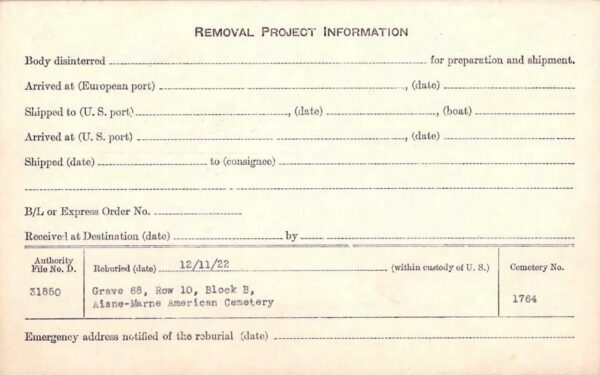Scroll 2 # 730
Born in Dothan, Alabama, on January 1, 1898, Wade was the son of Richard (Dick) Lafayette Pilcher, Jr. (1871-1941), who, with his eight siblings and parents, had moved from rural Dale County to Dothan in 1882. They lived at the corner of East Main and East Street, in the only painted house in Dothan, until June 9, 1893, when Dick’s mother died after throwing a bucket of water on their house which was on fire. The house was destroyed.
Despite this tragedy, the Pilchers prospered. Dick’s father and his sons operated a sawmill and lumber business, owned a grist mill, warehouse and cotton gin company, a saloon, and a turpentine distillery, and they constructed Dothan’s first brickyard, opera house, and municipal swimming pool. By the time of his death in 1900, Richard Lafayette Pilcher, Sr. and his sons had developed much of Dothan.
Meanwhile, Dick Pilcher married a local farmer’s daughter, Della Colista Bailey (1870-1913), who bore him five children, three boys and two girls. In 1900 Dick worked as a house carpenter in Dothan, and three years later he managed a dray company out of his Uncle George’s store. In 1910, they moved less than 30 miles southwest to Noma, Holmes County, Florida, where Dick ran a general merchandise store for area farmers. Dick later relocated to nearby Graceville.
Wade was the second oldest of the three boys, following in birth Woodfin Doyle (or W.D.) Pilcher (1896-1959) and preceding James Byrd Pilcher (1899-1996). Of the two brothers, only the younger one seems to have also served in the military during World War I, first in 1917-18 as a SATC cadet at Alabama Polytechnic Institute (Auburn University), from which he would receive both his undergraduate and master’s degrees, and later attending Officer Training School at Fort Sheridan, Illinois. In the 1930s, James Byrd Pilcher served as U.S. vice consul in Nanking and later Shanghai, China, and continued working for the State Department in Japan and Mexico through the 1950s.
Two years after his mother’s death in 1913, Wade Pilcher enlisted in the U.S. Marine Corps in Birmingham, Alabama, on April 27, 1915, giving his hometown as Chipley, Florida, some 14 miles south of Graceville. Since he was only seventeen at the time, he listed his birthdate as January 1, 1897, so he could qualify for the Marines enlistment age of eighteen or older. On April 29, 1915, Pilcher deployed to the Marine Barracks, Navy Yard, Norfolk, Virginia, training with Company I until July 31, 1915, when he boarded the battleship USS Connecticut at League Island Navy Yard, Philadelphia, for deployment to the Haitian capital of Port-au-Prince.
President Woodrow Wilson had sent Marines to Haiti to restore order and to protect American interests after the assassination of the Haitian President Jean Vilbrun Guillaume Sam, the seventh consecutive president assassinated or overthrown in four years. Pilcher was a private in 20th Company, 2nd Regiment, 1st Brigade, U.S.M.C., which landed in Port-au-Prince on August 4, 1915, and began securing the city and countryside. Within a few weeks he was ordered to Miragoâne, a coastal town some 60 miles west of the capital, where he remained until December 1916. During that time the U.S. Marines forcibly suppressed an insurgent rebellion and created, trained, and equipped the “Gendarmerie d’Haiti,” a local police force controlled by Americans throughout the occupation.
On March 4, 1917, the 7th, 17th and 20th companies of Marines stationed at Haiti embarked aboard the troop transport USS Hancock and sailed to Guantanamo City, Cuba, where they remained for several weeks of peacekeeping duties. Here Pilcher not only earned his Cuban pacification medal but also his promotion to corporal, effective May 18. Less than a week later, he was aboard the USS St. Louis for a return trip to the Navy Yard at Philadelphia. By early June 1917, Pilcher and his unit, which was now part of the 5th Regiment Base Detachment, were at the Marine Barracks in Quantico, Virginia, preparing to go to France, in the first element of the American Expeditionary Forces (A.E.F.). On August 1, Pilcher was promoted to sergeant. The 3rd battalion, 5th Marines arrived in Saint-Nazaire, France, via the navy transport USS Henderson on August 22, 1917.
Pilcher’s Marines Florida Service Card offers a snapshot of his military record.
President Wilson had directed that the Marines were to serve as part of an Army force, so they were assigned to the 2nd Division U.S. Army. Service as a part of this division consisted of detached training by experienced French and British officers for most of the regiment. From February 24 through March 25, 1918, Sergeant Pilcher attended a musketry school for small arms firing and tactics. The Marines also received instruction centered around the various phases of offensive and defensive trench warfare, including trench construction, grenade throwing, bayonet fighting, gas mask drills, and weapons firing at land targets and airplanes. It was not until March 1918 before the Marines, including Pilcher’s 5th Regiment, was ordered to the frontline, beginning in the relatively quiet Toulon Sector. Initially the 5th Regiment occupied the trenches centered around Les Esparges, 12 miles southeast of Verdun.
The 5th departed the Toulon Sector in mid-May, and proceeded to the Gizors training area, 38 miles northwest of Paris. Here, the regiment engaged in ten days of open warfare training. This, then, was the setting in the regiment, when suddenly on May 30, the 2nd Division, assigned to the French XXI Corps, French Sixth Army, received orders for movement eastward to stem the flow of onrushing Germans, whose surprise advance from the heretofore quiet Reims Sector threatened the very heart of Paris.
Retreating Allied soldiers and fleeing civilians choked the suburban Paris roads on which the 5th motored. After reaching Meaux, 25 miles northeast of Paris, the regiment continued the move by foot. Marching was made most difficult by the heavy loads on the backs of the Marines, the long grades over the dusty roads, the intolerably hot weather, and the sight of visibly dejected French soldiers who were in general retreat. When one French officer ordered a Marine officer to join the retreat, legend has it that Captain Lloyd W. Williams, of the 51st Company, 2nd Battalion startled the Frenchmen with, “Retreat hell. We just got here!”
On June 2, the 5th occupied reserve and forward positions, north of the Marne River and west of Château-Thierry, to assist the 2d Division in organizing the XXI Corps and in covering the withdrawal of French units still engaged. By June 4, the last of the withdrawing elements had passed through the Marine lines. During that day the 2d Battalion of the 5th repulsed by accurate rifle fire two enemy attempts to pursue the French through the battalion’s positions. It appeared that these setbacks handed the Germans caused them to halt their advance, for they then began to re-deploy troops for defense.
The Sixth Army ordered the XXI Corps to make two attacks on June 6. The first, in which the 5th’s 2d Battalion took part, was successful in straightening the Corps’ front. The second counteroffensive was planned to reduce the German salient into the left of the 2d Division. Since the Marines held this portion of the line, General Pershing ordered the 4th Brigade, including the 5th Regiment, to execute that mission. The designated objective, known at that time as Bois de Belleau (Belleau Wood), was to involve the Marines in one of their most famous fights. Taking almost half the Wood proved to be the costliest day in the Marine Corps’ 142-year history, with the 5th suffering almost two thousand killed or wounded. Among those who fell was Sergeant Luther Wade Pilcher, Serial No. 118457, the nineteen-year-old Floridian from Dothan, veteran of the Haitian and Cuban occupations of 1915-17.
For his service and sacrifice, the War Department posthumously awarded Wade Pilcher the Distinguished Service Cross and the Navy Cross, the second highest military decoration for the U.S. Army and Navy respectively, for “extraordinary heroism” in conflict against an opposing force. Sergeant Pilcher will serve as “an example to hitherto untried troops,” read one citation. Both awards were presented to his father, Dick Pilcher, in February 1919. Additionally, he also received the Fourragère, awarded by the French government to the 5th and 6th Marine Regiments for their actions during the war.
Exhumed from a wheat field near the Wood, Pilcher’s body was initially buried in Grave 59 American Battle Area Cemetery, less than one-third of a mile from Lucy-le-Bocage, Aisne, France. Disinterred and reburied on June 3, 1919, his remains were placed in Grave 26, Sec G, Plot 1, American Cemetery, Belleau, Aisne. He was finally reburied on December 11, 1922, in Aisne-Marne American Cemetery, Plot B, Row 10, Grave 68. Today, the cemetery contains the graves of 2,288 other war dead, most of whom fought in the vicinity of Belleau and in the Marne Valley in the summer of 1918.
